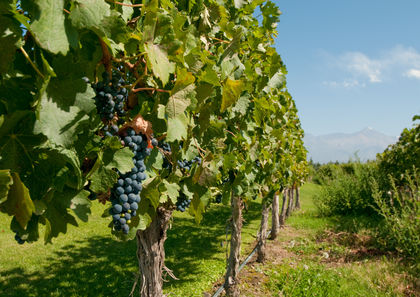Argentina - Agriculture

Agriculture and agro-industry in Argentina focus on the production of cereal, oil grains and seeds, sugar, fruit, wine, tea, tobacco, and cotton. Argentina is one of the greatest food-producing and food-exporting countries of the world, with an estimated 27,200,000 hectares (67,210,000 acres) of arable and permanent cropland. Agriculture and animal husbandry have traditionally supplied the nation with 70–95% of its export earnings, and the landowners have alternated the two activities in accordance with prices on the world market. As of 2001, agriculture made up 5% of the GDP. Agricultural products also accounted for 41% of exports by value. One of the most important factors in Argentine agriculture is the advanced degree of mechanization; in 1998, an estimated 280,000 tractors and 50,000 harvester-threshers were in use.
The principal agricultural region consists of the humid pampas, one of the world's greatest reaches of arable land. Argentine agriculture is virtually coextensive with this region, although efforts have been made to spread it into other areas. Citrus fruit, tobacco, cotton, and sugarcane are cultivated outside the pampas.
Wheat is the leading crop. Argentina accounted for about 75% of all wheat produced in South America in 1999 and was the world's fifth-leading wheat exporter. The area harvested in 1999 was estimated at 5.8 million hectares (14.3 million acres), and production at 14.5 million tons. Argentina is the fourth-largest corn-growing country in the world. The area harvested in 1999 was 2.5 million hectares (6.2 million acres), and production was 13.2 million tons. Barley is favored as the grain of greatest yield and resistance to disease; types for feed and beer are grown in the pampas areas having soil unfavorable or a climate too rigorous for wheat. Harvests once amounted to 659,000 tons per season in the early 1970s, but in 1999 production was 400,000 tons.
Rice is a major crop, with a 1999 production of 1,576,000 tons on plantings of 281,000 hectares (694,000 acres). Argentina is one of the world's biggest producers of flaxseed (linseed); production in 1999 was 85,000 tons, down more than 80% from the early 1990s. Most of the crop is exported in the form of linseed oil. The province of Tucumán dominates the sugar-raising industry, which dates from 1646; sugarcane production in 1999 was 19.4 million tons. To control overproduction, the government formed the National Sugar Co. in 1970 and forbade the construction of new sugar mills through the end of the decade.
Cotton growing dates from 1909 and is concentrated in Chaco Province. In 1999 the production of cotton fiber was 227,000 tons, down from 432,000 tons in 1996. Sunflower seed oil is a major industrial plant product; 3.8 million hectares (9.6 million acres) of sunflowers were harvested in 1999, producing 6,500,000 tons of sunflower seeds. Tobacco is raised in several northern provinces, especially Misiones; production in 1999 was an estimated 113,000 tons. Soybean production, only 78,000 tons in 1971–72, increased to 7.1 million tons by 1985–86, and to 18 million tons in 1999.
Fruit growing has developed rapidly since the 1940s. Estimates for 1999 fruit production (in tons) were apples, 1,056,000; oranges, 780,000; lemons and limes, 1,050,000; peaches and nectarines, 250,000; and grapefruit, 230,000. The output of bananas was 400,000 tons in 1974, 10 times the 1961–65 average; it fell to 144,000 tons in 1978 and rebounded to 280,000 tons in 1992 before declining to 175,000 tons in 1999.
The province of Mendoza is the center for the nation's vineyards. In 1999, grape production was 2.5 million tons. Argentina is one of the world's leading producers of wine, accounting for 1.26 million tons in 1999, or 4.5% of the world's total production.
is contact me, my email address is available.
i luv it lol bye :)